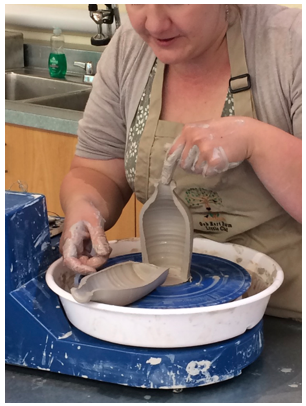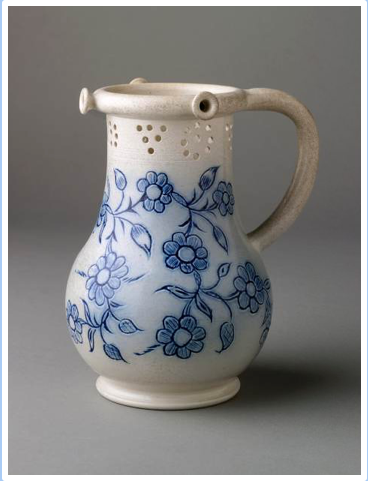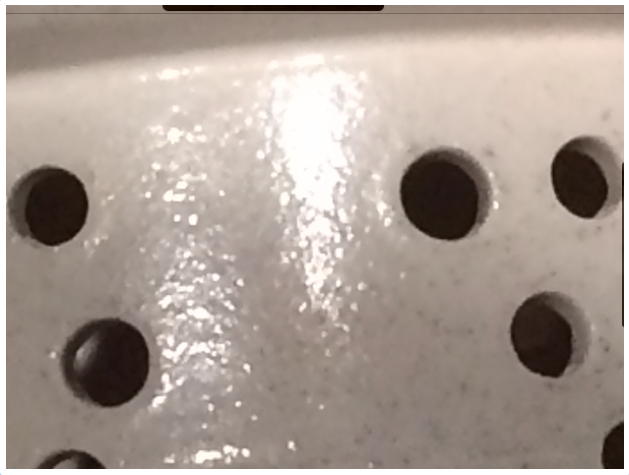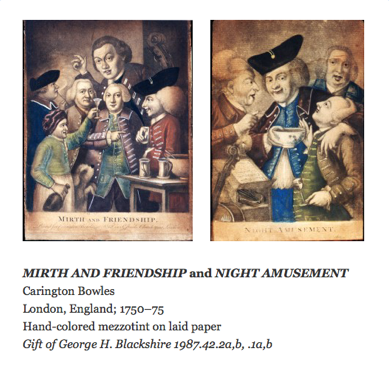Let the Games Begin!: Taking A Closer Look At A Puzzle Jug
During Summer Institute the first-year fellows attended a hands-on workshop that taught us how stoneware ceramics are made. Things came full circle during our ceramics connoisseurship block when I decided to research and present on a stoneware puzzle jug in the Winterthur collection.
Image: Stoneware clay is thrown on a wheel for first year students during our Summer Institute workshop. Here, the clay vessel has been cut in half in order to show students the horizontal throw lines that are created inside the bottle from the spinning wheel as the clay is shaped.
The puzzle jug I presented on for our ceramics connoisseurship block was also featured in Winterthur’s exhibition, Uncorked!: Wine, Objects & Tradition, and came into the collection in 1958 as a bequest of Henry Francis du Pont.
Image: This white salt-glazed stoneware puzzle jug is incised with scratch blue decoration and has a hollow rim and handle that connect with a straw-like structure.
The jug itself is made out of white stoneware clay and has a salt-glaze. White salt-glazed stoneware is an English stoneware with a dense clay body. When light hits the surface of the puzzle jug, it is possible to see the colorless but textured, orange peel-like surface, which is indicative of a salt-glaze. White salt-glazed stoneware was finely potted, and used for table and tea wares, tavern wares, and chamber pots. In this case, a tavern is the most likely setting for this puzzle jug.
Image: A close-up of the salt-glaze on the stoneware jug near the pierced holes in the vessel. The orange peel-like surface texture comes from salt being tossed into the glaze and is visible on the exterior of the ceramic body.
The decoration on this puzzle jug is called scratch blue. Scratch blue is usually used to describe white salt-glazed stonewares with incised designs, usually floral motifs. The incised lines in this puzzle jug are most likely filled with cobalt due to their blue coloration. Commonly seen on tavern wares and chamber pots, scratch blue designs typically date to post-1750. This stoneware puzzle jug has a date range of 1745-1770, putting it slightly earlier, but still within this target period of popularity.
Image: A close up of the body of the vessel shows the scratch cobalt-blue incised floral motif pattern on the body of the puzzle jug.
The puzzle jug contains lots of pierced holes. These holes are used to complicate the process of drinking from the vessel, creating a puzzle for the drinker. There are holes in the body of the ceramic and in its hollow rim and handle. In order to drink from this vessel, it is necessary to figure out (usually by trial and error) which holes to cover in order to create enough suction to get the liquid, typically beer, up the straw. This is often more difficult than it sounds, because puzzle jugs usually pop up in situations involving heavy drinking, dares, gambles, and friends.
Image: These pictures contain blue arrows pointing to pierced holes in the handle, rim and neck of the vessel. The correct combination of holes must be covered up in order to get the alcoholic liquid out of the jug, through the straw, and into one of the three protrusions that can be seen in the image on the right.
In other words, this puzzle jug is an example of an 18th century drinking game! Popular since Medieval times, puzzle jugs provided a form of entertainment for tavern-goers. These jugs were also used in the home and other private gatherings of friends. Games of risk, including gambling and cards, were also probably played in the same setting as this jug. Covering the holes in the puzzle jug would have been difficult enough for the sober mind to get right on the first try, let alone a beer-addled brain! As a result, the drinkers usually found themselves leaving their friends and/or the tavern in wet clothes soaked with the evidence of their unsuccessful attempts of drink from the puzzle jug!
Image: These two 18th century mezzotints by Carington Bowles are titled MIRTH AND FRIENDSHIP and NIGHT AMUSEMENT. Both images depict a group of male friends gathering together for drinks, games and fun. The image on the left, MIRTH AND FRIENDSHIP, depicts a man holding an alcoholic drinking vessel in a toast-like gesture, and a punch bowl sitting on a table near the group of friends. The image on the right, NIGHT OF AMUSEMENT, depicts three men trying to get a fourth man to drink from a puzzle vessel. The fourth man is pushing away the vessel in mild protest to the other men’s antics.
The next time you have a party with your friends or think that people in the 18th century did not know how to have a good time, remember the puzzle jug!
By Alexandra Rosenberg, WPAMC Class of 2019







Leave a Reply